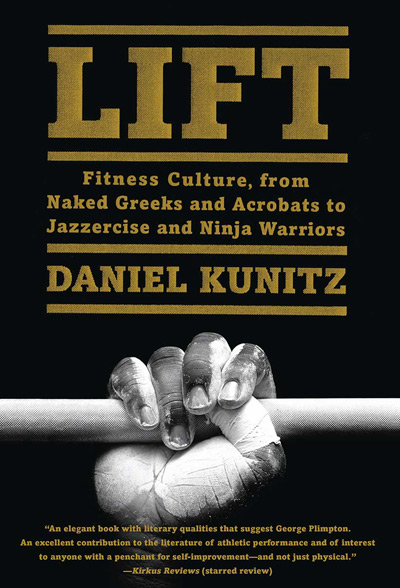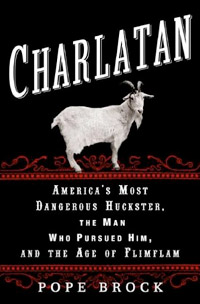This review of Lift: Fitness Culture, from Naked Greeks and Acrobats to Jazzercise and Ninja Warriors, by Daniel Kunitz (Harper Wave/HarperCollins. 2017. ISBN 9780062336194) was originally published in the Wall Street Journal in July 2016.

When I entered the world of serious cycling in 1980 I met a man named Phil Guarnaccia, a burly weight-lifting gym rat who could also pedal a bicycle with ferocity. On local group rides in Southern California he would routinely trounce men half his age (like me), and then retreat to his home gym and push iron for another couple of hours. I lived near Phil and worked out with him, and I would often see world-class athletes and Olympic cyclists there trying to figure out what they could do to enhance their performance (legally). He liked to tell the story of how, in 1952, he won the Mr. California bodybuilding contest and the Mr. Physical Fitness competition, and on a lark one Sunday morning he joined the San Francisco Wheelmen for a 30-mile loop through the rolling hills around the bay area. “I was dropped on the first hill and it wasn’t even that steep,” he told me. “And here I was, Mr. Physical Fitness, being thrashed by a bunch of skinny cyclists.” Phil realized that looking buff was not the same as being physically fit, and he vowed thereafter to train his whole body through multiple modalities. (He had a $5,000 challenge to anyone who could follow him through his daily gym workout routine and last the entire 45 minutes, which no one was able to do, including me).
This vignette is emblematic of the ever-evolving nature of fitness and the industry surrounding it, artfully narrated in Lift by Daniel Kunitz, a writer for Vanity Fair and Harper’s Magazine and an editor at the Paris Review. The latter is apropos for this book because the publication’s co-founder, George Plimpton, carved a literary niche for himself as a sports participatory journalist, famously playing quarterback for the Detroit Lions, going into the ring against the Light Heavyweight world champion boxer Archie Moore, playing goalie with the Boston Bruins hockey team, and flying through the air on a circus trapeze. But Plimpton wasn’t interested in actually becoming a jock, whereas Kunitz set out to sculpt his flaccid body (“muscles were for lunkheads” he once believed) into a physically fit athlete. But what does it mean to be fit? This book, among other things, sets out to answer this all-important question, starting with the physical form. (continue reading…)
Comments Off on What is Fitness, Anyway?
A review of Lisa Randall’s Knocking on Heaven’s Door: How Physics and Scientific Thinking Illuminate the Universe and the Modern World (Ecco, 2011).
LISA RANDALL HAS BEEN JUSTLY APPRAISED by Time magazine as one of the “100 most influential people in the world” for her work in theoretical particle physics. From her position at Harvard University, she often travels: to the European Laboratory for Particle Physics, CERN, in Switzerland, where her theories are being put to the test in the Large Hadron Collider (LHC); to speaking engagements with professional and public audiences about her work in particular and the awe and wonder of science in general; and to rock formations where her chalked fingers can find ways to defy gravity. On the side, she writes popular books, such as her acclaimed Warped Passages1.
In Knocking on Heaven’s Door, Randall picks up the story from where she left off when the LHC was years away from first collision, expanding her horizon from, as she poetically puts it, “what’s so small to you is so large to me” to “what’s so large to you is so small to me.” In other words, the book ranges from the smallest known particles to the entire bubble universe, from 10−35 meters (the Planck length, where quantum gravity rules) to 1027 meters (the entire visible universe, 100 billion light-years across, where dark matter and dark energy dominate), a stunning 62 orders of magnitude. (Randall correctly notes the age of the universe at 13.75 billion years, clarifying her apparently paradoxical figure of 100 billion light-years thusly: “The reason the universe as a whole is bigger than the distance a signal could have traveled given its age is that space itself has expanded.” She unpacks that sentence in the book.) (continue reading…)
read or write comments (4)
Although you wouldn’t know it by watching the local news, humankind is becoming more civilized
This review of The Better Angels of Our Nature: Why Violence Has Declined by Steven Pinker (Penguin Books, 2012. ISBN 9780143122012) appeared in The American Scholar in August 2011.
In John Ford’s classic 1962 film, The Man Who Shot Liberty Valance, a clash of moral codes unfolds in the Wild West frontier town of Shinbone. Under the Cowboy Code, disputes are settled and justice is served between individuals who have taken the law into their own hands, and under the Law Code, disputes are settled and justice is served by institutions because most members of society have agreed to obey the rules. The Cowboy Code is represented by John Wayne’s character, Tom Doniphon, a gunslinger who enforces justice on his own terms through the power of his presence backed by the gun on his hip. The Law Code is embodied by Jimmy Stewart’s Ransom Stoddard, an attorney hell-bent on seeing his beloved Shinbone embrace the rule of law. Lee Marvin’s Liberty Valance is a coarse highwayman who respects only one man, Tom Doniphon, because they share the Cowboy Code. Despite Valance’s constant flouting of the law, Stoddard holds to his belief that until Valance is caught doing something illegal there can be no justice. When Doniphon tells Stoddard, “You better start packin’ a handgun,” Stoddard rejoins, “I don’t want to kill him. I just want to put him in jail.” At long last, however, Stoddard takes Doniphon’s advice that “out here a man settles his own problems” and turns to him for gunfighting lessons. When Valance challenges Stoddard to a duel, the overconfident naïf accepts and a late-night showdown ensues. In a darkened street, the two men square off. Stoddard trembles while Valance mocks and scorns him, shooting first too high and then too low. When Valance takes aim to kill, Stoddard shakily draws his weapon and discharges it. Valance collapses in a heap. Having felled one of the toughest guns in the West, Stoddard goes on to become a local hero, building that image into political capital and working his way up from local politics to a distinguished career as a U. S. senator. (continue reading…)
Comments Off on Getting Better All The Time
This review of The Brain and the Meaning of Life by Paul Thagard (Princeton University Press, Princeton, NJ, 2010. ISBN 9780691142722) appeared in Science Vol. 328, Issue 5979 in May 2010.
Twice I have spoken at the TED (Technology, Entertainment, Design) conference. Twice I have begrudgingly agreed to the strictly enforced 18-minute talk format—grumbling that “ideas worth spreading” (the TED motto) could not possibly be conveyed in such a constrained format. And twice have I been proven wrong. With discipline and diligence you really can say something of substance in a tight space, and more than 200 million downloads of endlessly entertaining and educational videos prove the principle of pithiness. (continue reading…)
Comments Off on Meaning-Making Neurons
A torrid tale of quackbusting in 1920s America
sheds light on modern medical scares
A review of Pope Brock’s Charlatan. America’s Most Dangerous Huckster, the Man Who Pursued Him, and the Age of Flimflam.
Human cognition has a problem — anecdotal thinking comes naturally whereas scientific thinking does not. The recent medical controversy over whether vaccinations cause autism illustrates this barrier. On the one side are scientists who have been unable to find any causal link between the symptoms of autism and the vaccine’s ingredients. On the other are parents who noticed that shortly after having their children vaccinated autistic symptoms appeared. (continue reading…)
read or write comments (4)




